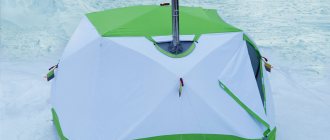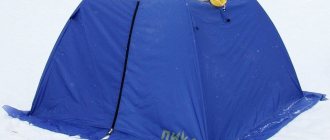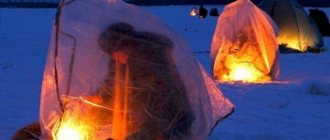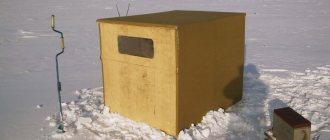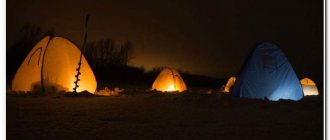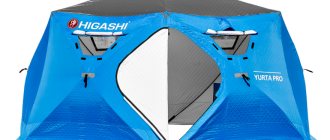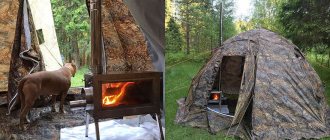Choosing a tent for a winter overnight stay
There are many types of winter tents on sale. They can be divided into two large groups:
- automatic;
- frame.
The machines are quick to assemble and disassemble, but the design is short-lived and unstable in the face of strong winds. If you buy them, you should pay attention to the manufacturer’s brand. When installing, you will need to not only insulate the tent yourself, but also secure it to the ice using metal pegs with beveled corners or screws.
Frame ones are more reliable, although it is more difficult to install them yourself. Such products are recommended for winter parking. When purchasing, pay attention to several parameters:
- The material should be quite dense, but breathable. Artificial fabric does not allow air to pass through, which will cause the accumulation of not only moisture, but also carbon dioxide. Therefore, when assessing this indicator, you need to pay attention to vapor permeability.
- The color of the product is light. Dark reduces the light level, so it will be uncomfortable inside.
- The tent should have a bottom - then it will be easier to insulate it with your own hands.
- Dimensions of the structure: the smaller, the better it retains heat. Typically, products of 150*150, 200*200 cm are chosen. It is important to evaluate the dimensions when folded. The design should fit into a hiking backpack.
- Shape: round is considered more stable, although a square tent can be securely strengthened with your own hands.
- Frame: metal is stronger than plastic. But the price difference will be significant. If you use a tent in open areas (where the wind constantly blows), it is preferable to choose a metal one.
- Fastenings: a more reliable option when the extensions are fixed to the arches. If they are attached tightly to the material, then you can expect the structure to break.
- The doors must have 2 locks with zippers: internal and external.
Advice! When choosing a tent, you need to pay attention to the presence of windows, pockets, hooks, hangers, and other additional elements that you cannot make with your own hands.
A winter tent should not be too bulky
How to make a tent bottom yourself
Manufacturing will require straight hands, materials, a measuring tool, a sewing machine, or a lot of patience and free time. In fact, making the bottom of a tent yourself is not at all difficult.
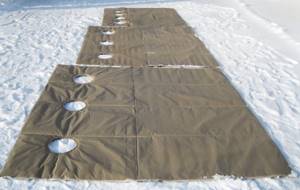
The first thing you should do is accurately measure the disassembled tent . Based on this, the required amount of material will be purchased and a working diagram will be drawn up. If you're going to make a floor for a tent that already has a floor, it's even easier. Take a worn sample and record all its geometric parameters. Be sure to pay attention to the way the bottom is attached to the main awning of the tent. You will have to either make a new type of fastening, or completely repeat the old one. If we are talking about a winter tent for fishing, then it is quite possible to fix the bottom with loops on the protrusions of the umbrella frame or in the corners of the cube.
Next you will need material - material can be obtained in several ways. Buy the material itself - impregnated Oxford fabric, or buy a large inexpensive awning with the required water resistance and sew the bottom from it. It is much easier and more convenient to buy awnings. It will be a little more expensive than the original material itself, but the awning can be found in any store.
If we are talking about a winter day for fishing, which is most likely, you will need zippers and insulation .
Zippers are sold at any sewing store; you need to buy them as long as possible and preferably with leakage protection.
Izolon or any porous material for thermal insulation can be used as insulation
Choosing a place to set up a tent
When parking in the cold season, it is important not only to insulate the structure well with your own hands, but also to choose the right place and secure it. This is easy to do if you know some rules:
- If there is a prevailing wind direction, then the entrance should be located on the opposite (leeward) side.
- If the tent is square, then you need to position it with your own hands so that the main wind flow blows at the corner, i.e. she should stand with a wedge towards him.
- If possible, the structure should be placed in an area protected from the wind (near a hill, trees).
- When installing it yourself, the underskirt is fixed with stones and heavy objects. You can throw in a lot of snow. Experts do not recommend freezing, because then it is difficult to assemble the shelter.
Attention! If there are trees or old buildings nearby, it is necessary to position the structure as far as possible from them.
A tent is an indispensable thing for winter fishing
When planning winter fishing, it is necessary to provide for many situations in which lovers of this extreme recreation may find themselves.
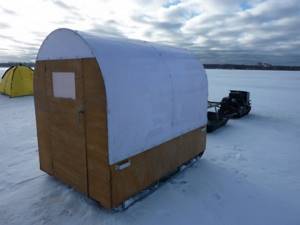
A self-made tent, as well as equipping it with necessary household items, will take into account all the individual needs of the creator, and thereby not only preserve his health, but also provide the necessary comfort and safety in difficult weather conditions.
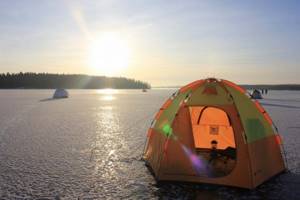
Materials for insulating a winter tent
There are several popular winter tent insulations that you can install yourself. For these purposes use:
- isolon;
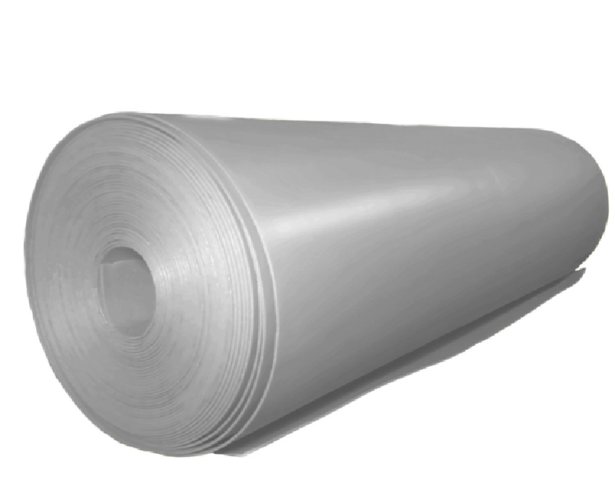
- penofol;

- blanket;
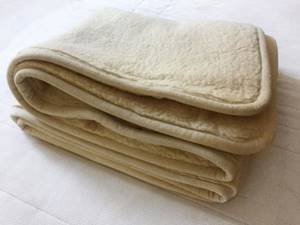
- padding polyester with foil;
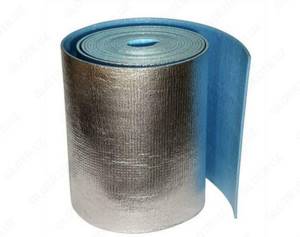
- batting;
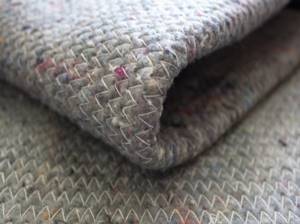
- felt;
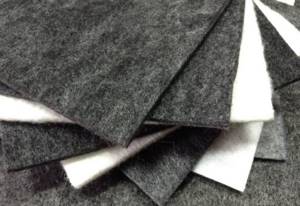
- travel rugs;
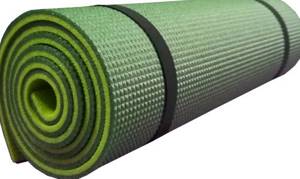
- thick polyethylene film;

- polyethylene foam;
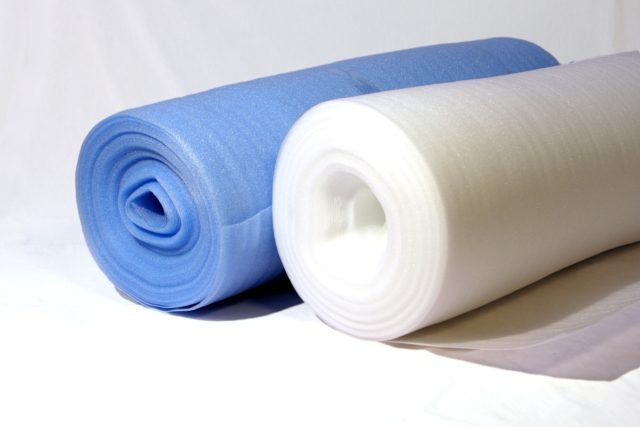
- Oxford fabric and others.
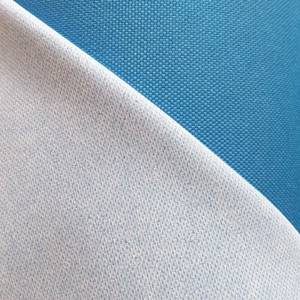
DIY winter tent photo
Read here Summer girder: a step-by-step description of how to make it yourself and how to catch fish with it (105 photos)
Help the project, share on social networks 

0
How to insulate a tent in winter with your own hands
It is necessary to insulate the structure both outside and inside. The air cools quickly, so it is better to take care of comfortable conditions in advance.
Insulating the tent from the outside
There are several ways to insulate the outside. A suitable option is to lay breathable fabric from an old (Soviet) tent. It allows air flow and moisture to pass through.
You can put plastic film, secure it with clamps, and stones underneath. It retains heat well, but does not allow air to pass through. Therefore, you will have to periodically ventilate the room.
Insulating the tent from the inside
You can insulate the walls inside with the following materials: an old blanket, padding polyester with foil, isolon, penofol.
Artificial insulation is more expensive, but it is more durable. As for the blanket, it will only have an effect for a few hours. Then additional heating will be required, including forced heating.
How to insulate the bottom of a tent
To maintain a comfortable temperature, you need to insulate the floor of the tent.
Important! The bottom of the structure is in contact with the cold ground, so a significant part of the heat loss occurs through it.
You can insulate with the following materials:
- Felt – warms due to the wool content, and allows moisture and air to pass through well.
- Travel mats are affordable and easy to use.
- Isolon is used to insulate the tent floor. This is an artificial material characterized by good thermal insulation properties and durability.
- You can insulate the floor with your own hands using special fabrics. Oxford 300, Lotus PU4000 and others are suitable for this purpose.
- Another option is to insulate the floor yourself using foamed polyethylene foam (PPE).
Advice! An effective way is to insulate the floor of a winter tent with a laminate underlay.
Floor leveling sheets are made from natural materials (pine, cork). They allow air to pass through well, but you must put plastic film under them.
Warm winter floor for universal tents UP
You can order a heated floor for a UP tent if you are planning to buy or have already bought a universal tent from a production company.
The types of heated floors produced for winter tents UP have an octagonal shape and several varieties of diameter: from 2.9 to 4.8 meters
The main characteristics of insulated floors for UP tents are moisture resistance and heat retention in a winter tent.
A warm floor for a universal tent can be installed in 2 ways: under the tent and inside the UP tent itself. In the first case, you completely isolate the cold from the surface of the earth, in the second, by installing it inside, you will significantly reduce natural condensation, which is a natural phenomenon, and the place where it occurs is the lower part of the tent - the dew point.
How to quickly heat a tent
Even if you insulate your tent well with your own hands, in winter it still needs additional heating. For this purpose the following devices are used:
- Gas stoves are portable devices powered by small cylinders (several hours of continuous burning). They are convenient because they can be used for both heating and cooking.
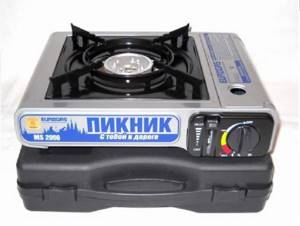
- Alcohol burners are quite convenient and do not emit harmful substances during operation. But you can’t cook food with them, and you’ll also need to take a container of alcohol.
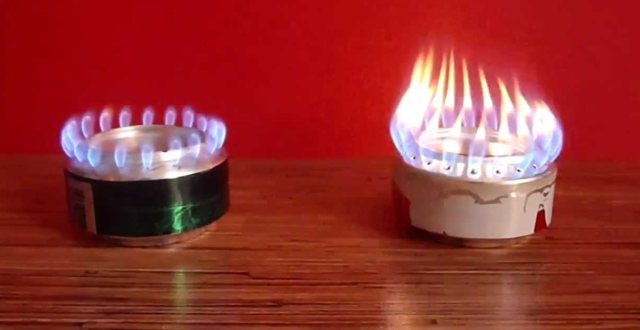
- Dry fuel is a very simple option and does not take up much space. It is enough to put the tablet in a tin can with a pre-made hole and set it on fire. But when the tablets burn, they release harmful substances, so you won’t be able to use them for too long.

- Infrared film has a heating element and a flexible surface. It is usually used to heat balconies, but can be taken into a tent.
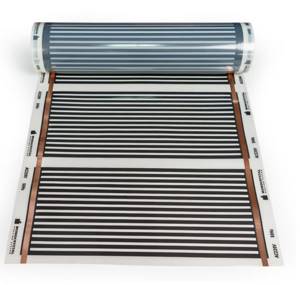
- Primus petrol tourist. You can use it to heat your tent. The device is also used for cooking.

- Candles (wax, paraffin) are an affordable and cheap way. It is advisable to use them only in warm weather. To insulate small rooms, for example, raincoats, candles are rarely used due to the fire hazard.
Buying a Suitable Tent
Of course, the most obvious way to save heat is to use a winter tent. However, you should not think that it will warm a tourist or hunter at night, as some naively believe. A winter tent simply allows you to slightly reduce heat loss. There are practically no ventilation inserts, and the fabric is much denser. Thanks to this, the heat is better retained in the tent and is not blown away by a slight wind.

But it’s worth considering that such equipment weighs 1.5-3 times more than regular equipment. If you travel by car, then this will not cause any special problems: what difference does it make whether the tent weighs 2 kilograms or 5? But if you prefer winter hiking, then an extra 3 kilograms is a very serious weight that needs to be taken into account. Only experienced, hardy tourists should be trusted to carry such a tent. Or a good solution would be to divide the load - if the tent consists of two layers and guides, then they should be distributed to several tourists. In this case, everyone will have to carry a relatively small load - this will significantly delay the onset of fatigue.
A very good choice would be to buy a tent with an inflatable bottom. Then there is much less risk that you will have to think about how to provide warmth for a winter tent. After all, cold comes from the frozen ground, from which even tourist foams do not always save you. But an air gap of 10-15 centimeters will reliably protect you.
Don't forget about the sizes. Ideally, the tent should correspond to the number of “inhabitants” - you should not choose too large. Still, it is much easier to warm a small tent with your warmth and breath than one intended for four, in which only two will sleep.
Tips and tricks
You can insulate a room in different ways. There are general tips that are successfully used by fishermen and hunters:
- If there are no devices or they are broken, you can use a large stone for heating (heat it over a fire and place it on a board). It warms up the air in the room for 5–6 hours. A less successful option is a container of boiling water. It will give heat, but it will produce a lot of steam.
- A layer of dense polyethylene must be laid under the floor (from the outside). Due to the constant heating from the bottom, the ice will partially melt, resulting in a puddle.
- Insulating the floor with your own hands is quite simple. If you use fabric materials, it is important to take into account that they do not insulate thread seams well (you will need to glue them with sealing tape). If you use artificial material (for example, PPE), you need to take into account that this is a product for one trip - its wear resistance is very low.
- When using any heating devices, fire safety must be observed. They are installed on a stone or other object made of non-flammable material, away from flammable objects.
- You can insulate a 2-person tent with your own hands. However, instead of one layer of material, it is better to lay 2, since a larger volume requires more efficient heat retention. A powerful heating device must be installed in such structures.
Insulating the bottom of the tent
Unfortunately, it is not always possible to purchase a tent with an inflatable bottom that protects from the cold of the ground and snow. This means you need to make a warm tent with your own hands. This can be done in different ways.
First of all, it is advisable to cover the entire bottom area. Do you have extra clothes left that you won't be wearing any time soon? It should be spread along the bottom, covering the area not covered with mats. This is very important, as it can significantly reduce heat loss. You can also put your clothes under yourself - on top of the mattresses. Of course, there is a risk that they will go astray at night and cause unnecessary discomfort. But it will be much warmer to sleep.
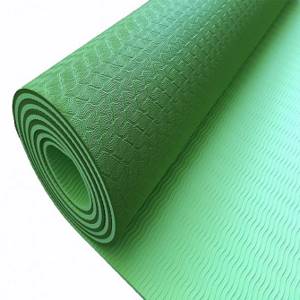
Another proven method is to use two mats, preferably quite thick ones. Still, if you have to sleep on frozen ground at -20 degrees and below, then one summer rug will probably freeze and will not perform its function. This definitely won't happen with two. Fortunately, although the foam is quite large in size, it weighs a little, which means that the backpack will not become much heavier.
Another good solution would be to buy an inflatable mat designed for cold weather. It will cope perfectly with the function of thermal insulation. By the way, if the mat is already thick, then you can put excess clothes in a sleeping bag with you - additional thermal insulation. The main thing is that after this, do not forget to ventilate it to get rid of excess moisture.
